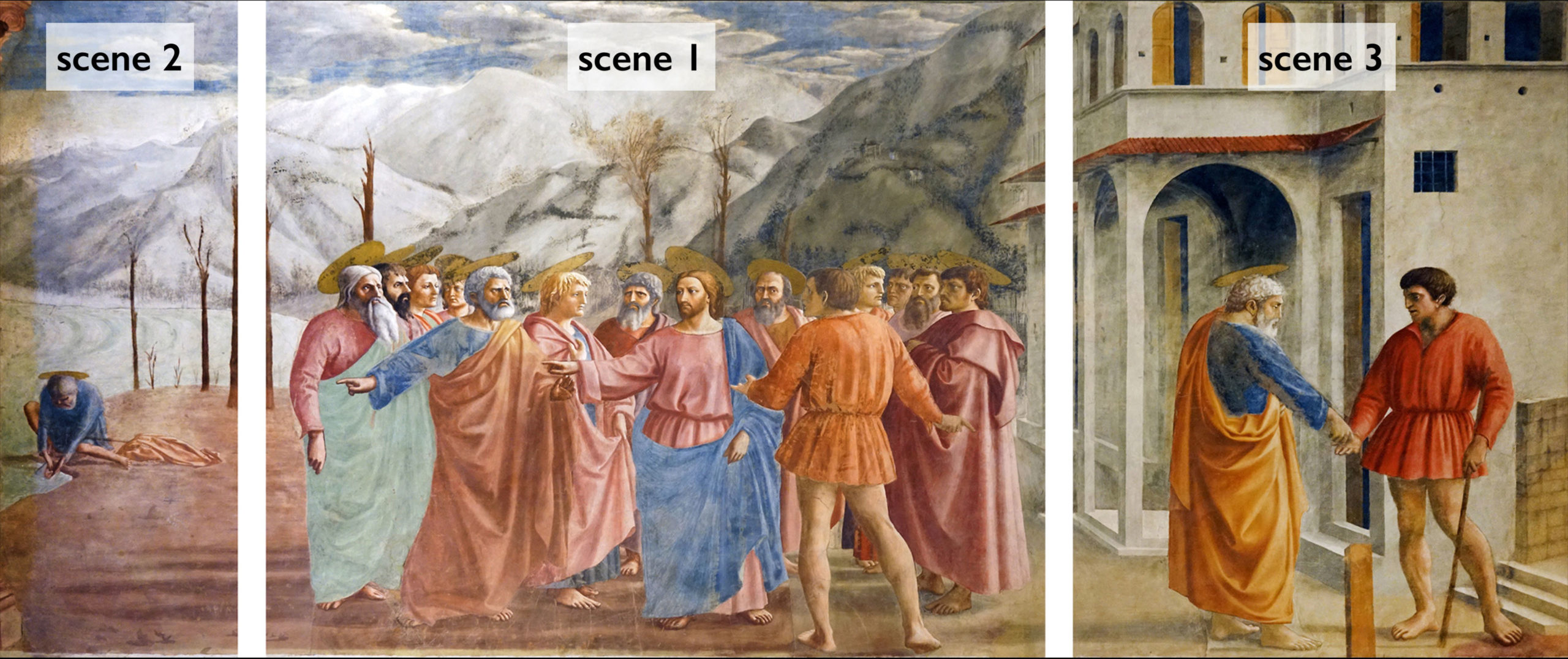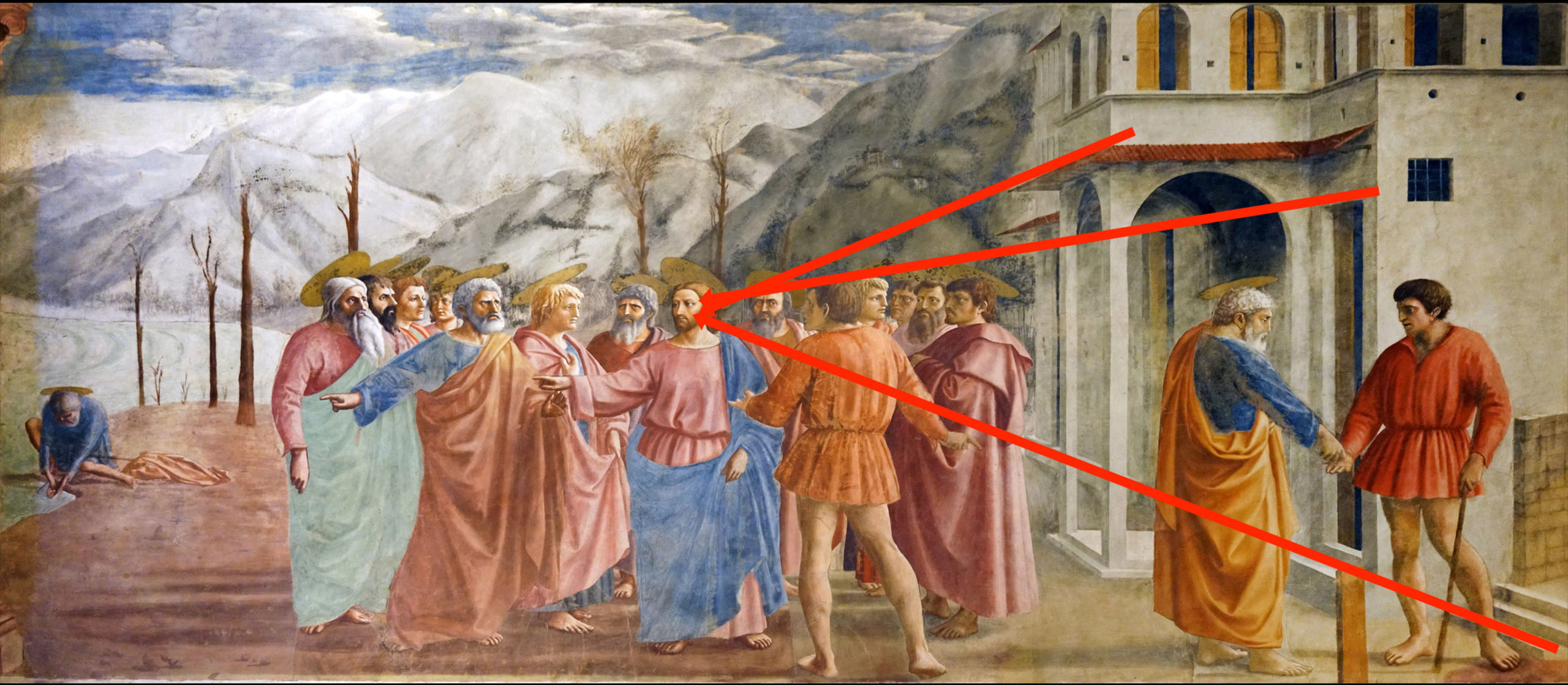The Tribute Money is a fresco painted by the Italian Early Renaissance artist Masaccio between 1425 and 1427. It is located in the Brancacci Chapel of the Basilica of Santa Maria del Carmine in Florence as part of a fresco cycle depicting the life of Saint Peter. The scene represents an episode found only in the Gospel of Matthew (Matthew 17:24-27): Jesus instructing Peter to pay the temple tax with a coin he would find in the mouth of a fish. The work is considered one of the early and influential examples of the use of single-point (linear) perspective, atmospheric perspective, and light-and-shadow (chiaroscuro).
History
The Brancacci Chapel began to be decorated between 1425 and 1427 by Masaccio and Masolino da Panicale with scenes from the life of Saint Peter. When Masolino left for Hungary and Masaccio went to Rome—where he died in 1428—the fresco cycle was left unfinished. The work was completed between 1481 and 1485 by Filippino Lippi.
The foundation of Santa Maria del Carmine was laid in 1268, but the structure was not completed until the end of the 15th century. In the great fire of 1771, much of the church was damaged, but the Brancacci Chapel survived unharmed. During extensive restoration works in the 1980s, The Tribute Money was cleaned, regaining a look close to its original colors and details.

Santa Maria del Carmine, Florence (Italy). (SmartHistory)
Subject and Narrative
The fresco presents the scene from Matthew 17:24-27 in three stages, using the continuous narrative technique:
1. Central scene – The tax collector approaches Jesus and the apostles to demand the tax. Jesus instructs Peter to retrieve the coin from the fish’s mouth.
2. Left background – Peter removes the coin from the fish’s mouth on the shore.
3. Right foreground – Peter hands the coin to the tax collector.
The tax collector appears twice, and Peter appears three times. The central figure of Jesus is the focal point of both the narrative and the perspective.

Scene 2 – Scene 1 – Scene 3, The Tribute Money. (SmartHistory)
Composition and Perspective
Masaccio applied Brunelleschi’s principle of single-point perspective by arranging the orthogonals of the architectural elements to converge at Jesus’ head. The buildings on the right emphasize these perspective lines. The figures are placed in a semicircle, following the curve of the chapel’s apse.
Atmospheric perspective is achieved by rendering the mountains in the background and the left-hand Peter figure in paler tones compared to the foreground, thus enhancing the sense of depth.

Example of Single-Point Perspective, The Tribute Money, Masaccio. (SmartHistory)
Light, Shadow, and Figurative Qualities
Breaking away from the neutral light of earlier periods, Masaccio introduces a single light source coming from the right side of the chapel. This light creates a sense of volume and weight in the figures, while the shadows cast on the ground give them a tangible presence in space. The figures exhibit the classical contrapposto stance; the tax collector, for example, is depicted with his weight on a different leg in each of his two appearances.
Facial expressions vary: Jesus is calm, Peter appears slightly angry and restless, and the other apostles are depicted as anxious or expectant. The consistency of light direction and shadows enhances the three-dimensional effect of the figures.
Iconography and Symbolism
- Jesus: Wearing blue and pink tones, placed at the center and vanishing point, forming the spiritual focus of the scene. His hand gesture indicates both the narrative direction and divine authority.
- Peter: His triple appearance reinforces his role as the founder of the Church and the vicar of Christ. The blue and yellow garments in the right-hand scene allude to papal colors.
- Tax collector: His short tunic and bare legs emphasize low social status. The reddish tones symbolize tension and worldly authority.
- Background landscape: Mountains rendered in pale tones through atmospheric perspective symbolize the distance between earthly and spiritual realms.
- Continuous narrative: Peter’s three actions (receiving the order, carrying it out, delivering) represent the stages of apostleship and duty.
- Architectural frame: The building on the right recalls contemporary Florentine urban architecture, bringing the scene into a familiar, contemporary context.
Artist: Masaccio (1401–1428)
Tommaso di Ser Giovanni di Simone, known as Masaccio, was one of the pioneers of Early Renaissance painting. Despite his short life, his innovative approach to perspective, light-and-shadow, anatomy, and volume left a lasting impact on art history. Alongside Donatello and Brunelleschi, he helped establish the visual language of the Renaissance in Florence. The Brancacci Chapel frescoes, especially The Tribute Money, served as an important learning source for many artists, including Michelangelo.
 Peter (Detail), Masaccio, The Tribute Money, 1427. (SmartHistory)
Peter (Detail), Masaccio, The Tribute Money, 1427. (SmartHistory)
Artistic and Historical Context
This rarely depicted biblical scene is interpreted in the context of church–state financial relations in 15th-century Florence. A possible connection is drawn to Pope Martin V’s acceptance in 1423 of the Florentine Church being subject to state taxation. In addition, the image of the coin from the fish’s mouth may symbolize the message that Florence’s wealth, strengthened by maritime trade, came from the sea.
The Brancacci family’s choice of a Saint Peter-themed cycle reflects a pro-papal political stance. The work is seen as a representation of Saint Peter’s earthly and spiritual authority.


